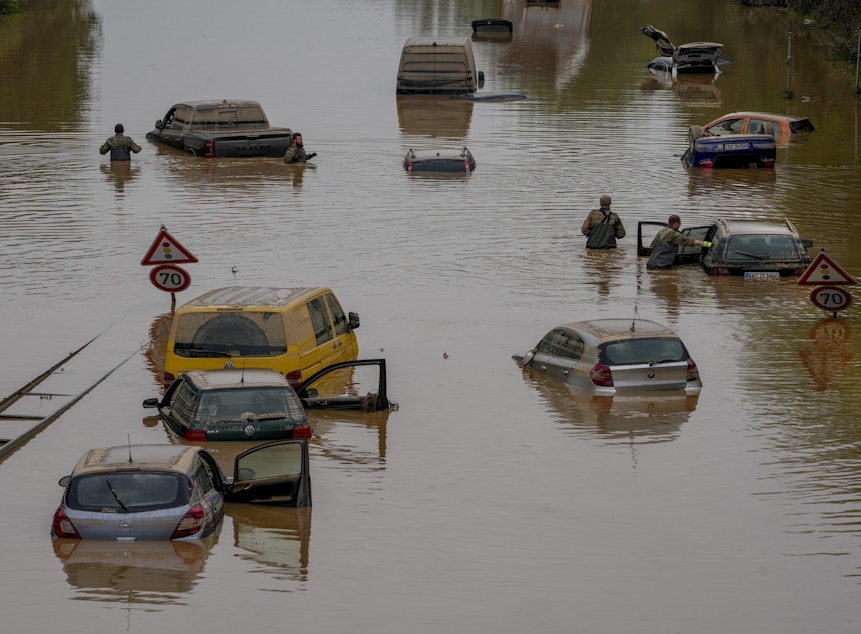From German Floods To The Northwest Heat Dome: How Climate Change Is Juicing Extreme Weather Events

German Chancellor Angela Merkel is facing tough questions Wednesday as she tours damage from the devastating floods last week that killed at least 165 people.
Many Germans are asking why their country — a rich nation famous for its engineering and its leading role in climate change negotiations — could be caught so tragically off guard when faced with the kind of extreme weather that climate scientists have been warning about for years.
Friederike Otto, an associate director of the Environmental Change Institute at the University of Oxford and an associate professor in the Global Climate Science Programme, studies the connections between climate change and extreme weather events.
Otto says it doesn’t come as a surprise to her when meteorologists estimate a small area in Germany could see more than 18 gallons of water downpour in just a few hours.
“It’s one of the very well-known aspects of climate change that we see more extreme rainfall … coming down in a shorter time,” she says.
It’s something many countries, especially tropical ones, are already experiencing due to their hotter climates, Otto says.
In other countries familiar with severe floods, such as the United States and Bangaladesh, advisories warn people about imminent weather events and allow them to prepare accordingly. The alerts are sent out on phones and broadcast on television and radio.
Germany, however, doesn’t have a weather alert system, she says.
“People are not educated that weather can be dangerous,” Otto says. “I think [it’s] one of the really important aspects of why the death toll was so high.”
In addition to building up its efforts to educate the public, she says it’s essential that Germany re-naturalize its built-up floodplains, flat areas of land beside rivers or streams. Germany is an industrial, densely populated area, which has caused water to build up in its floodplains over time, affecting flood exposure and risk.
“When rain like this folds down, it just has nowhere to go,” Otto says. “So another important adaptation measure … [is to] give the river some space to go, because otherwise, it goes where people are and literally drowns them.”
Other wealthy countries experiencing intense weather events like Germany are also beginning to realize their infrastructure cannot withstand the effects of climate change, she says.
“I think this hubris that we’ve seen in Germany in particular, that ‘nothing will happen here because we are this historically engineering nation’ is certainly waning,” she says.
And the revitalization of rich countries’ infrastructure also applies to their response to major heat waves. In a scientific study, Otto says she and her colleagues found that the extremely high temperatures in the U.S. Pacific Northwest region would not have existed without man-made climate change.
The event is rare, only happening once in 1,000 years with the current 1.2-degree change of global warming. But if temperatures rise another .8 degrees, this event would occur every 5 to 10 years, she says.
With major climate change conversations taking place in November, Otto says she hopes this year’s extreme summer heat demonstrates the importance of keeping global temperatures from rising, the consequences of burning fossil fuels, and the significant infrastructure changes that wealthy countries need to make.
“Heat waves are by far the deadliest extreme event in the developed world,” she says. “And I don’t think that that has really hit home yet. I really hope that we don’t need more wake-up calls than this summer has shown us.”
For people continuing to experience intense heat waves in the U.S. Pacific Northwest, Otto strongly advises people to take preemptive cooling measures this summer, especially vulnerable populations such as the elderly and those living in low-income neighborhoods.
“A very simple measure that one can do [is] drink a lot of water,” she says. “We have seen… public buildings that were air-conditioned were open so people could go there and cool down. But people need to know that’s what they have to do, otherwise [they] might die.”
To alleviate the consequences of severe heat, Otto says cities need to implement green spaces to prevent what is called the “heat island effect,” in which cities have higher temperatures due to their concrete foundation.
“We need to redesign cities, to have more trees, to have more parks,” she says, “just to keep temperatures lower and prevent people from dying from heat.”
Chris Bentley produced this interview and edited it for broadcast with Jill Ryan. Xcaret Nuñez adapted this interview for the web.
This article was originally published on WBUR.org. [Copyright 2021 NPR]
